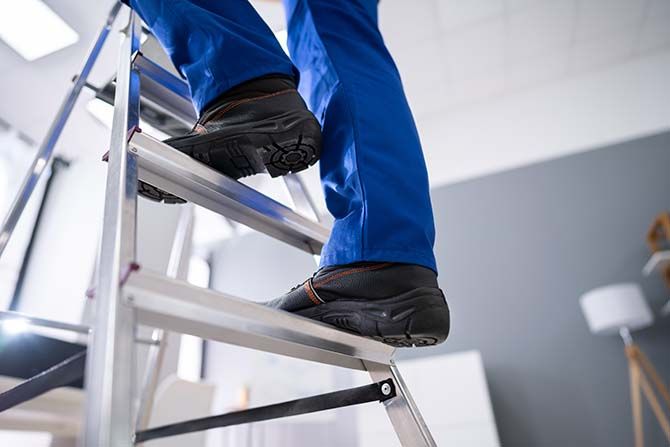Ladders are a common tool used in a variety of everyday tasks, but using them properly is essential for avoiding accidents. Whether you’re a professional or a do-it-yourselfer, you must understand and follow the safety guidelines for ladder usage. In this article, we’ll cover the basics of safe ladder usage and provide tips on how to prevent accidents and injuries.
It is most important to make sure you are using the correct ladder for the job. Using a ladder that is too tall or too short can lead to overreaching, climbing too high, or awkward positioning, which can lead to the ladder tipping over, needing to stand on the top rung to reach, or leaning off the side of the ladder.
After the correct ladder has been chosen, it needs to be inspected. According to OSHA’s Standard 1910.23(b)(9), ladders need to be inspected before initial use in each work shift and more frequently, as necessary, to identify any visual defects that could cause employee injury. This inspection includes looking for loose steps, rungs, bolts, broken or damaged parts, and also making sure climbing and gripping surfaces are free of debris and other slippery contaminants.
Always maintain three points of contact on your ladder at all times. This means either two feet and one hand or one foot and two hands need to make contact at all times. By doing this, your body should be positioned near the middle of the step. You should always face the ladder when climbing up and down the ladder. Avoid carrying tools up and down while climbing the ladder.
When ladders are needed, make sure the ground they are positioned on is a stable, level surface. If the area is a soft or uneven surface, a support can be put underneath the ladder and leveled to make sure the ladder has a stable place to rest. The ladder must be secured at the bottom to ensure there is no slippage or displacement.
When a ladder needs to be used, make sure there is enough space around the ladder and your work area. It is important to make sure nothing will fall into or hit the ladder while you are using it. This might involve placing an orange safety cone, or other similar devices, so your coworkers are made aware and will avoid any possibility of bumping into the ladder while an employee is on it.
When ladders are not in use, they should be stored either by chaining or securing them to the wall via hooks that the ladder rungs can be placed on or by laying them down on their side. Doing this will prevent them from tipping over and striking a worker or a vehicle if they are bumped into. This also helps to prevent things from getting piled on top of the ladders when they are not in use, which could cause damage to the legs, supports, rungs, etc. Have you checked to see how your ladders are being stored?










